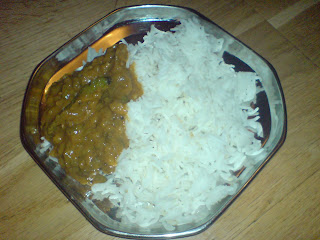
A Madhu Jaffery recipe again with a twist. This is from her book ‘The flavours of
- Prawns - 600 gms (Shelled and deveined)
- Onion - 1 (medium sized thinly sliced into half moons)
- Garlic - 5 (cut into thin pieces)
- Ginger - 1 inch (grated)
- Chilli powder - ½ tsp
- Paprika - 2 Tbsp
- Turmeric Powder - ¼ tsp
- Coconut milk - 400 ml
- Curry leaves - 1 twig
- Green chillies - 3
- Tamarind - lemon size
- Mustard seeds - 1 tsp
- Oil - 2Tbsp
- Salt as required
Dry roast the coriander seeds, fenugreek seeds and pepper and powder it in a blender with the curry leaves. Once the powder is fine add 5 raw prawns to it and grind it with some water. Heat the tamarind with water for 2 minutes on high. Dilute with cold water and extract the juice. Heat oil and add the mustard seeds and when they pop add the curry leaves, onion, garlic and fry till brown. Once brown add the ginger and sauté for one more minute. To this add the chilli, paprika, turmeric powders and the ground paste and fry till blended. Add the tamarind extract, salt,green chillies and let it bubble. To this gravy add the coconut milk and the prawns. When the prawns are cooked, remove from fire and enjoy with hot boiled rice. If you enjoy very spicy food, the paprika can be replaced with chilli powder. The gravy is thick and would go well with Chapatti as well. This dish is a treat for your senses. It looks, smells and tastes divine.


























